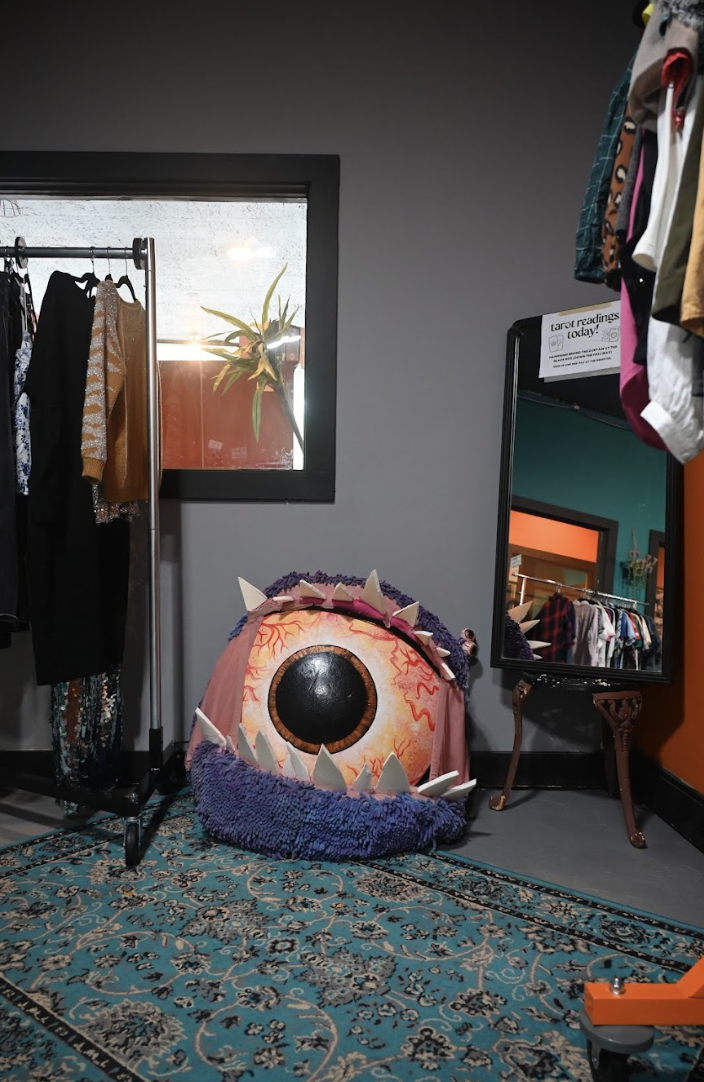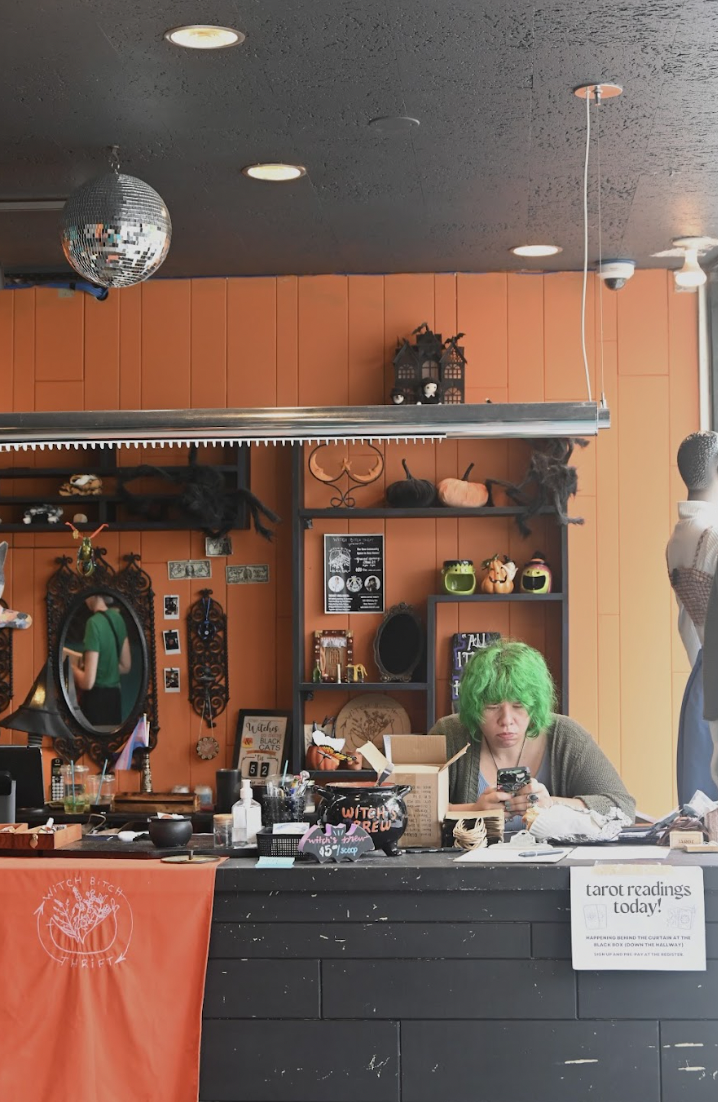My first time between the clothing racks at Witch Bitch Thrift, I was a stranger at an intimate conference on the workings of witchhood. A stone cat-owl stared at me silently. Galaxy-colored soaps carved to resemble human torsos stood nearby, bound by lengths of black rope in ostensibly kinky ways. I found my reflection in a small object, labeled a “scrying mirror.” The unfamiliar term unnerved me—had I violated some unwritten rule by looking directly at it? I turned to Wikipedia for some relief: “Scrying, also referred to as ‘seeing’ or ‘peeping,’ is a practice rooted in divination and fortune-telling.” I looked up and saw no enlightening vision, but noticed the friendly fine print underneath the label: “Yep, you can take them off the wall to look at them!” I heaved a sigh of relief.

A few days later, I sat and talked with Virginia Semeghini and Eva Ray, who met in music school in Connecticut a few years ago, and are now life partners who run Witch Bitch together. Ray was wearing a black t-shirt that said “PLACEBO,” her undercut visible beneath a headband from which felt coconut trees protruded. Semeghini wore a long dark flowy skirt and holographic-framed glasses, sporting winged eyeliner and pointy nails, too. Together, we traced the origin of Witch Bitch Thrift.
One morning in 2020, Semeghini was sipping coffee, pinching herself awake, when she stopped to muse on how she wished an “alternative, cool, kind of witchy, kind of queer” second-hand clothing store existed. “I was just throwing words around my brain, being like witch bitch thrift, witch bitch thrift…? Wait, that sounds really cool.” Immediately, she signed up for as many social media handles under Witch Bitch Thrift as possible and bought the domain for the website.
In retrospect, Semeghini says that her sense of urgency to create Witch Bitch Thrift stemmed from her desire for both accessibility and aesthetic in thrifting. Semeghini remembers hearing lots of “horror stories” from queer people about walking into the women’s or men’s section in a thrift shop, only for a staff member to direct them the other way. With Ray and Semeghini also struggling to find plus-size clothing in mainstream thrift stores like Goodwill and The Salvation Army, she decided to make Witch Bitch Thrift into a space where clothing of all sizes and a wide range of aesthetics could be found.
Witch Bitch Thrift began by selling clothes out of Semeghini and Ray’s Bridgeport living room. The business then moved into the Bridgeport Innovation Center, where people could physically visit. After outgrowing the space, Witch Bitch Thrift—along with Ray and Semeghini—officially moved to New Haven in January 2023. Even before the big move, Witch Bitch Thrift had always been inseparable from the city of New Haven. After all, the store’s largest customer base came from New Haven; Ray and Semeghini’s first two dates were in the city; and many of their regular customers, friends, and collaborators lived nearby. Semeghini recalls Ray telling her, “Well, if we want to be a big deal, New Haven’s definitely the best place.”
Centuries before Witch Bitch Thrift played its part in furthering Connecticut’s fascination with all things witchy, witchhood had already captivated the popular imagination. In the seventeenth century, national attention to witchcraft first took form as an ostracization of the other, resulting in the shunning and killing of suspected witches. The mass paranoia surrounding the Salem Witch Trials was just as much about alienating the atypical as it was a fear of witchcraft.

Witch Bitch Thrift sets out to serve the witch and the witchy alike. Witchcraft, broadly encompassing solitary practitioners and followers of religions like Wicca, is part of the larger contemporary pagan movement based on pre-Christian religions and cultures. But beyond spiritual affiliation, there has been a rise of the witchcore aesthetic online. Witchcore reclaims and embraces traditional witchhood’s unorthodoxy, with feminine-presenting people wearing all black, sporting piercings, and reading tarots and crystal balls, expanding traditional boundaries of femininity and organized religion.
Perhaps the alternative nature of witchiness encourages its associations with queerness. On TikTok, videos under the tag #witchylesbians have accrued more than one hundred fifty-two thousand views. Yet, in the popular imagination, witchiness has remained in that same narrow stereotype of feminine women in black gowns, or as Ray puts it, in the style of “black goth,” “something you can get out of Hot Topic during Halloween,” and “chains, D-rings, studs, heavy makeup.” Though this aesthetic may seem hyper-specific to some, this does not limit Witch Bitch Thrift’s cultivation of an open, queer community space.
When Witch Bitch Thrift first started posting on Instagram, Ray and Semeghini constantly received comments and direct messages from people who thought that their items were “not witchy enough,” because most of Witch Bitch Thrift’s stock strays from all-black clothing. But at Witch Bitch Thrift, being witchy is less about meeting a set of criteria and more about following one’s own intuition and beliefs. To Semeghini, who identifies as a practicing witch, “putting out your moon water” or “performing your rituals regularly” only matters if your heart’s in it. To Ray, witchiness does not come in any defined form for a non-follower of specific sects of witchcraft. “You can be witchy and dress like anything, it’s about you…There can’t be a box, if you forget there’s four walls there.”
Witch Bitch Thrift is size-inclusive and does not categorize its clothes by gender. All items that go through the shop are hand-measured, then sorted into categories clearly delineated on their universal size chart, such that customers are not confused by the arbitrary sizes that different companies label their clothes. In an Instagram Reel, Semeghini speaks about how, on their online store, there are even armhole or thigh hole measurements for each garment, as well as fabric tags that flag textures like wool and velvet for people with sensory sensitivities. She ends with “What else could we do to make it easier? Let us know!”
And customers let them know: last year, after pushback, the two decided against selling Harry Potter merchandise, considering that J.K. Rowling had recently come under fire for her transphobic comments on social media. If Hogwarts is a demonstration of false inclusivity, then Witch Bitch Thrift is its antithesis, a place dedicated to being a warm and vibrant haven for everyone who steps into it.
Nicholas Shamp and William Rosedale, regular customers at Witch Bitch Thrift, appreciate that the store fills the niche of an alcohol-free, homey LGBTQ+ friendly space. To them, Witch Bitch Thrift is more than just a thrift shop; it’s family. Shamp hand-painted the store mannequins’ nails. He also sewed the curtains for the Witch Bitch Black Box, which is a community space within the store with a mini stage and couches. It’s where Ray and Semeghini organize events like drag king nights, tarot readings, biweekly open mic nights, and a series of concerts by acoustic queer artists (aptly named Acoustiqueer), attracting audiences from New Haven and beyond.
One time at the store, Ray told me that she really liked my sweater. On the way out, I stopped in front of the scrying mirror and saw my reflection. I thought about how my sweater was plain, white, and frankly uninteresting. I looked myself in the eyes—and felt a little bit witchy.
–Kinnia Cbeuk is a sophomore in Timothy Dwight College and an Associate Editor of The New Journal.

